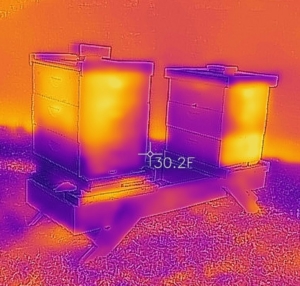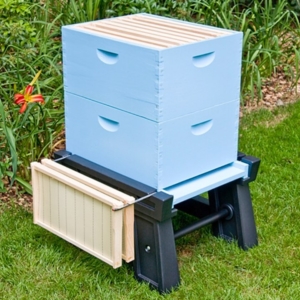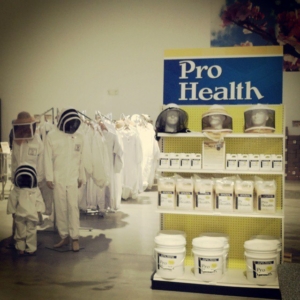Thank you for reading my blog! If it’s your first February in a role of beekeeper – you might be interested in my article about getting started beekeeping.
February is a slight extension of the events that occur in January. Days and nights are still particularly cold, but there are more bursts of warm weather that will affect your bees.
On those warm days, which for the bees is above 55°, the forager bees will leave the hive looking for pollen. Pollen is in high demand in February because the bees need the protein from the pollen to feed their larva. They combine the fresh pollen with the residual capped honey from last year to feed their bees.
There is a lot you can tell from your hive by just watching the entrance. Activity significantly increases at the entrance around 1-2 pm each day, so that is the best time to observe (Flow hive 2 is still a best hive for observation, I think). Look for bees bringing in pollen on their back legs, that is always a good sign. If you don’t see any activity, it is a possibility the bees are dead.
While the amount of eggs being laid by the queen is increasing, it isn’t by too much compared to January. The reason for this is the adult bees have to keep the capped and uncapped brood warm, about 90° and above.
If a major cold snap occurs and the bees have to ball together very tightly to keep warm, it may leave the outer edges of the brood nest partially exposed to the cold. If the brood gets too cold, it won’t survive and all the cold brood must be removed from the hive during the next warm period by the bees. This is why the bees slowly expand their egg laying, so they will have enough adult bees to keep the unhatched bees warm.
With each round of capped brood that hatches out, the population will increase. In early February, the adult population may be around 10,000 bees, but by the end of the month, it will likely be closer to 18,000.
Temperature inside the bee hive
Thermal Camera Update
The red/yellow core on the box shows where the brood nest is. The center of the nest is located mostly in the top medium box and some of the 2nd box. Much of the heat from the bees collects directly above the cluster and is being dissipated across the inside cover.
A thermal camera image of 2 hives in February, each with three medium 10-frame boxes. The bright yellow areas show the general area of adult bees and the brood nest. This goes to who that these hives are building their population quickly, but still do not keep the entire hive warm. They only work to keep themselves and the brood nest warm. Plastic bee hives resolve this issue, otherways you should keep eyes peeled on thermic regime.

What are beekeepers doing in February?
February will often present beekeepers the first opportunity to take a look inside the hive. But only do so on days that are above 55 degrees. Try to disrupt the hives as little as possible and preferable do so just before a warm spell.
March is the month when a lot of beekeepers receive their purchased bees, so don’t get caught off guard when they come. Take the time you have during February to make those “last-minute” preparations.
This is a great time to prepare new locations for bees by leveling off ground and setting up hive stands. Hive stands can be as simple as cinder blocks or as complex as a purpose-built structure set in concrete. No matter how you set up your new location, it’s easier before bees arrive. February is a good time to adjust existing hive stands. Did the grass grow up too high around the hives last year? If so, you can put weed blocker down now or even asphalt shingles to keep the grass down.
Don’t forget that the bees need a place to live. If you don’t have the equipment yet, check out our website here to see if we can help. We can paint and/or assembled equipment for you as well to save time.
If you already have the equipment, now is the time to assemble or to give the paint touch up. You can even paint the hives that have bees in them on days below 55°. Usually, after some time in service, most equipment needs a touch up here and there.
Many beekeepers use pollen patties to help their bees. They often cause to build up their population very quickly. Which is helpful for some beekeepers, but can cause swarms beekeepers who are new. Use pollen patties very conservatively. More is not better with pollen patties.
If you are an established beekeeper, make a plan for what you want to do this year. Swarms and swarm cells are going to appear before you are ready. Are you going to let nature run it’s course or are you going to try and reduce your swarms this year? Either way, it’s good to have a plan. Swarm boxes are always a great idea, so get those up and out about 10′ off the ground so your bees can find them.
Swarm lists are usually posted by many beekeeping clubs. If you are interested in wrangling some bees from a neighbors yard, add your name to your clubs swarm list and you will likely get a call this spring. Be prepared though, as swarms don’t wait for you to get your swarm catching equipment together.
When it’s a warm day, preferably at the beginning of a warm spell, you can take a peek at your bees. Don’t rifle through every frame in the hive, just take a look from the top down. Usually, you can look down through every frame in the hive if you just take the inner cover off. The hive will just be lightest it will be all year, so give it a heft on the back to see how heavy it is. If you do this throughout the year, you can start gaining some muscle memory on how much honey is inside the hive.
Feed your bees only if necessary to prevent starvation this time of the year. If they have over 4 frames of capped honey inside the hive, your bees are in good shape. But that 4 frames can be eaten quickly, so keep an eye on it until spring comes.
What is coming up in beekeeping in March?
March is a big month for bees. Bees starting thinking about swarming in early March and are well on their way to swarming by late March. Massive bee population expansions happen in March and you start to get the earliest glimpses of flower blooms. Tie up your bee boots folks, cause March is when things start to pick up for the bees and learning how to start a beehive.
See you soon!
Keep updated.

